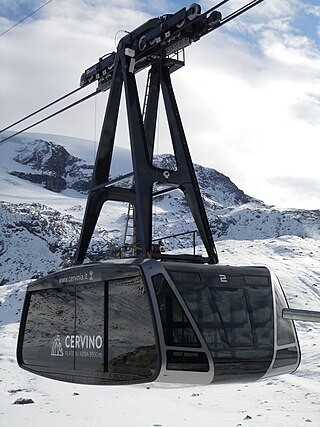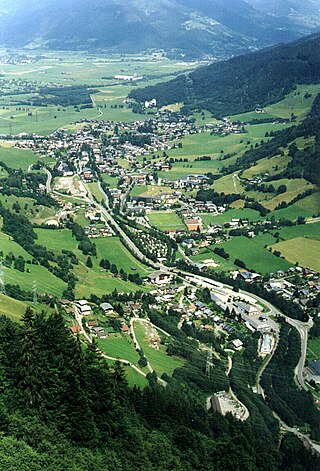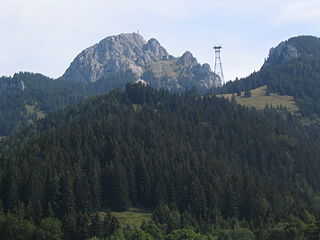
Cable transport is a broad class of transport modes that have cables. They transport passengers and goods, often in vehicles called cable cars. The cable may be driven or passive, and items may be moved by pulling, sliding, sailing, or by drives within the object being moved on cableways. The use of pulleys and balancing of loads moving up and down are common elements of cable transport. They are often used in mountainous areas where cable haulage can overcome large differences in elevation.

An aerial tramway, aerial tram, sky tram, aerial cablecar, aerial cableway, telepherique, or seilbahn is a type of aerial lift which uses one or two stationary ropes for support while a third moving rope provides propulsion. With this form of lift, the grip of an aerial tramway cabin is fixed onto the propulsion rope and cannot be decoupled from it during operations. In comparison to gondola lifts, aerial tramways generally provide lower line capacities and higher wait times.

On 11 November 2000, a fire in the tunnel of Gletscherbahn Kaprun 2 funicular in Kaprun, Austria, killed 155 people. The cause was traced to a faulty fan heater. Most of the victims were skiers on their way to the Kitzsteinhorn Glacier. To date, this incident remains the deadliest rail disaster in Austrian history.

At 1,493 metres (4,898 ft) the Feldberg in the Black Forest is the highest mountain in Baden-Württemberg, and the highest in Germany outside of the Alps and Bavaria. The local municipality of Feldberg was named after the mountain.

A funitel is a type of cableway, generally used to transport skiers, although at least one is used to transport finished cars between different areas of a factory. It differs from a standard gondola lift through the use of two arms attached to two parallel overhead cables, providing more stability in high winds. The name funitel is a portmanteau of the French words funiculaire and telepherique.

Zermatt is a municipality in the district of Visp in the German-speaking section of the canton of Valais in Switzerland. It has a year-round population of about 5,800 and is classified as a town by the Swiss Federal Statistical Office (FSO).

An aerial lift, also known as a cable car or ropeway, is a means of cable transport in which cabins, cars, gondolas, or open chairs are hauled above the ground by means of one or more cables. Aerial lift systems are frequently employed in a mountainous territory where roads are relatively difficult to build and use, and have seen extensive use in mining. Aerial lift systems are relatively easy to move and have been used to cross rivers and ravines. In more recent times, the cost-effectiveness and flexibility of aerial lifts have seen an increase of gondola lift being integrated into urban public transport systems.

Sankt Anton am Arlberg, commonly referred to as St Anton, is a village and ski resort in the Austrian state of Tyrol. It lies in the Tyrolean Alps, with aerial tramways and chairlifts up to 2,811 m (9,222 ft), yielding a vertical drop of 1,507 m (4,944 ft). It is also a popular summer resort among trekkers and mountaineers.

Kaprun is a municipality in the Zell am See District in the province of Salzburg in Austria. Together with the neighboring city of Zell am See the town presents itself as the tourist destination and skiing area "Zell am See-Kaprun". Kaprun distinguishes itself from its larger neighbor at the lake, by offering all year access to the Kitzsteinhorn with its Top of Salzburg viewing platform at 3029 metres (9938') altitude and its glacier ski area that is open October through May.

The Kitzsteinhorn is a mountain in the High Tauern range of the Central Eastern Alps in Austria. It is part of the Glockner Group and reaches a height of 3,203 m (10,509 ft) AA. The Kitzsteinhorn Glaciers are a popular ski area.

The Seilbahn Zugspitze is an aerial tramway running from the Eibsee Lake to the top of Zugspitze in Bavaria, Germany. It currently holds the world record for the longest freespan in a cable car at 3,213 metres (10,541 ft) as well as the tallest lattice steel aerial tramway support tower in the world at 127 metres (417 ft). Construction of the system began in 2015 and it opened on 22 December 2017.
The Gant-Hohtälli Aerial Tramway is a large-cab cable car near Zermatt, Switzerland. It is 2,707 metres (8,881 ft) long and spans an elevation of some 1,057 metres (3,468 ft). This cable car is notable in that it runs over the tallest aerial lift pylon in Switzerland, with a height of 94 metres (308 ft).

An aerial lift pylon is a pylon construction bearing the cables of an aerial lift such as an aerial tramway or gondola lift. Large pylons of aerial tramways usually consist of a steel framework construction, smaller pylons of gondola lifts are made of tubular steel. Early aerial tramways often had pylons of reinforced concrete and ropeway conveyors had timber pylons, if they were cheaper than steel pylons.

The Wendelstein Cable Car (Wendelstein-Seilbahn) is a 2,953-metre (9,688-foot) long cable car running from the village of Bayrischzell Osterhofen to Mount Wendelstein in the Bavarian Alps in Germany. It has a maximum speed of 10 m/s (32.8 ft/s) and its travel time is 6.5 minutes. The cabins each take up to 50 passengers, and the cable car system has a transport capacity of 450 people per hour. The cable car climbs an altitude difference of 932 metres.

The Magic Mile is an aerial chairlift at Timberline Lodge ski area, Mount Hood, Oregon, U.S. It was named for its unique location above the tree line and for its original length. When constructed by Byron Riblet in 1938, it was the longest chairlift in existence, the second in the world to be built as a passenger chairlift, and the first to use metal towers.

The Tyrolean Zugspitze Cable Car was the first wire ropeway to open the summit of the Zugspitze, Germany's highest mountain on the border of Austria. Designed and built by Adolf Bleichert & Co. of Leipzig, Germany, the system was a record-holder for the highest altitude.

The Port Vell Aerial Tramway is an aerial tramway in Barcelona, Catalonia, Spain. It crosses Port Vell, Barcelona's old harbour, connecting the Montjuïc hill with the seaside suburb of Barceloneta.

Arosa Lenzerheide is a ski area located in Arosa, Lenzerheide, Valbella, Parpan and Churwalden, Graubünden/Switzerland. It originated 2013/14 by connecting the existing ski areas of Arosa and Lenzerheide. With a total of 225 kilometers of ski slopes and 43 cable cars it is the largest contiguous ski area in Graubünden.


















